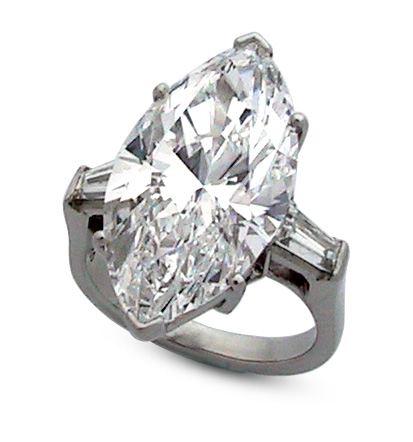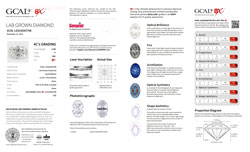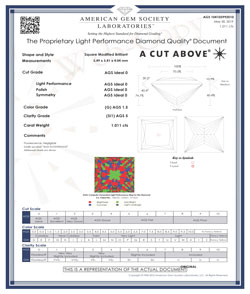New technology, new standards for diamond cut
Cut, the most important of a diamond's 4Cs in terms of value, has been given short shrift. Appraisals usually overlook it. Even reports from grading labs have often confined cut to a one-word description, such as good or excellent, with no information on how that grade was determined.
Now it appears that cut is the new frontier in diamond grading.
AI, artificial intelligence, which is affecting so many aspects of our lives, is also having an impact on diamond grading and on the diamond reports that insurers see.
For round brilliant diamonds, the finest cut proportions, proportions that show the diamond to best advantage, have been established for some time.
For fancy shapes, like oval, marquise, princess, and others, establishing a grading standard has been a trickier task.
GCAL & Sarine Technologies have joined forces.
GCAL (Gem Certification and Assurance Lab) is a major diamond-grading lab. Though GCAL has only one location, it is widely recognized for its grading accuracy.
The lab recently developed 8X cut grading, which assesses eight aspects of a diamond's cut to determine its quality: polish, external symmetry, proportions, optical brilliance, fire, scintillation, optical symmetry, and hearts & arrows.
The report includes a verbal description of the named quality along with a photograph showing how the diamond in question displays that quality. The 8X report is available for both mined and lab-grown diamonds.
Sarine Technologies Limited has pioneered most of the sophisticated technologies that the diamond manufacturing world relies upon. Its products are used at every stage of diamond processing, from imaging the diamond rough to determining the best cutting and shaping of a given stone. The company's DiaMension® family of products are used by gemological institutes, diamond cutters and wholesalers to quickly evaluate the proportions and symmetry of a diamond.
Sarine also brought artificial intelligence to determining color and clarity of a diamond. In all these diamond grading tasks, AI can distinguish subtleties that the human eye cannot see and it can achieve a consistency beyond what is possible for humans.
With the merger, Sarine gains access to GCAL's gem-grading expertise, and GCAL benefits from Sarine's sophisticated AI technology.
GIA and AGS have merged.
The American Gem Society (AGS) has closed its lab and merged operations with the Gemological Institute of America (GIA).
GIA developed the internationally accepted standards for color and clarity grading, while AGS has developed a system for analyzing cut quality and light performance in diamonds that can be applied to multiple diamond shapes and facet arrangements.
Both companies were founded by in the 1930s and have collaborated in the past. The recent closing of AGS's labs was a strategic decision to allow the Society to focus on its original mission of education and membership programs, while the combined AGS and GIA teams focus on new products and services.
GIA currently offers the AGS Ideal Report, which grades diamond's light performance, as a digital supplement to GIA's widely respected reports on the 4Cs. However, the Ideal Report is available only to "eligible" GIA reports, only for certain diamond shapes, and only for diamonds with specific facet arrangements.
In the competition to provide the most accurate and complete grading information on a diamond, particularly cut information, and especially for fancy shape diamonds, it looks like the GCAL-Sarine team is positioned to set a new standard, and GIA will be pressed to up its game to stay competitive.
FOR AGENTS & UNDERWRITERS
Gem-grading labs usually offer various versions of reports, with higher priced reports giving more information. Layouts may also vary. Check to be sure the reports you receive have descriptions of all 4Cs.
Cut plays a crucial part in valuation of a diamond. Two finished diamonds, equal in all respects except cut proportions, can vary as much as 50 percent in price. Precise and detailed information is especially important for high-value diamonds.
For cut information, look for a diagram like the one pictured in the GCAL report above. Or look for a list of cut terms: table size, crown height, crown angle, girdle, pavilion angle and pavilion depth, along with their percentages.
Reputable labs for verifying reports you receive:
GCAL https://www.gcalusa.com/certificate.html
GIA https://www.gia.edu/report-check-landing
AGL https://www.aglgemlab.com/contact
AGS https://www.americangemsociety.org/agslab/
(AGS is no longer issuing lab reports, but its past reports can be checked using the link above.)
FOR ADJUSTERS
When pricing replacements, look for cut information on all appraisals and diamond reports. Words like excellent or very good are too vague to be of much use. Look for the numbers.
For a damage claim, have the gem inspected in a gem lab to determine cut proportions (as well as to verify other qualities) before settling the claim. Remember that cut accounts for as much as 50% of a diamond's value.
For a damage claim, it may be useful to send the diamond to GIA for a damage report.
©2000-2025, JCRS Inland Marine Solutions, Inc. All Rights Reserved. www.jcrs.com




